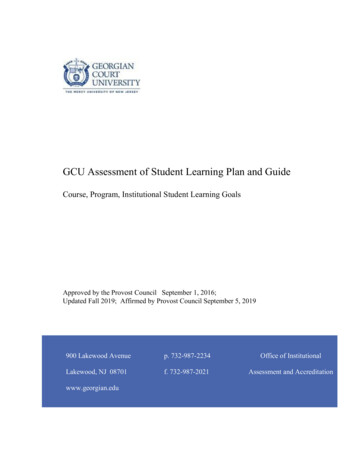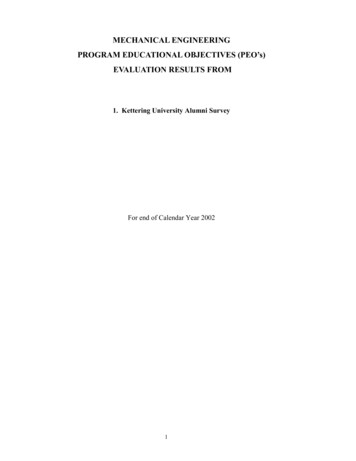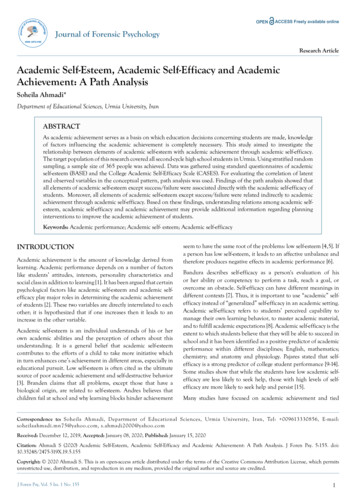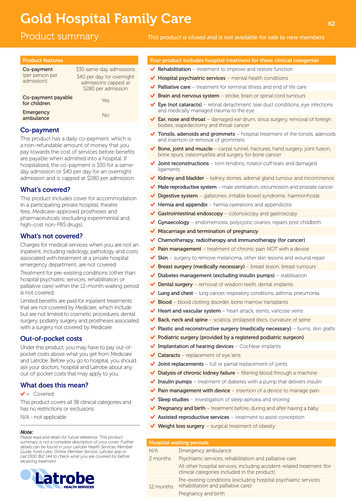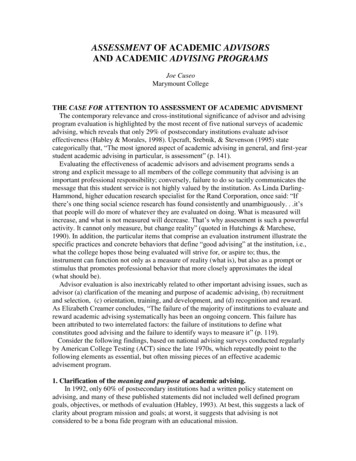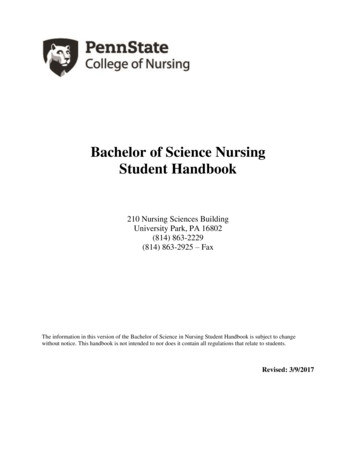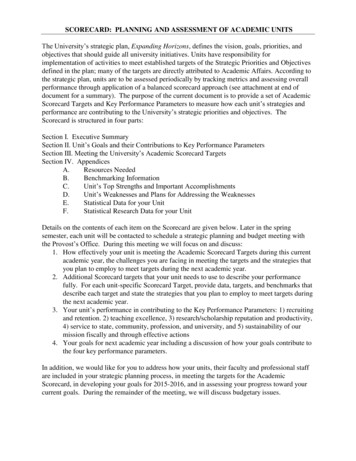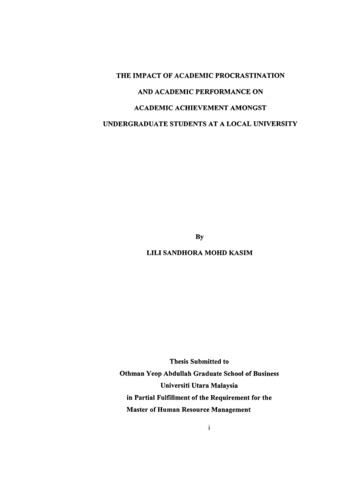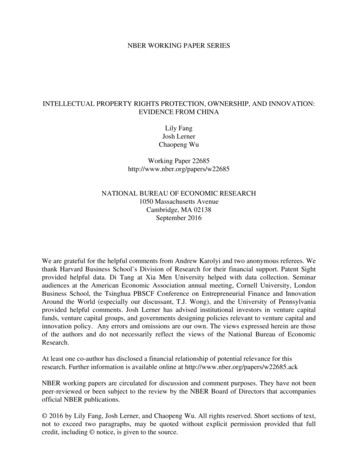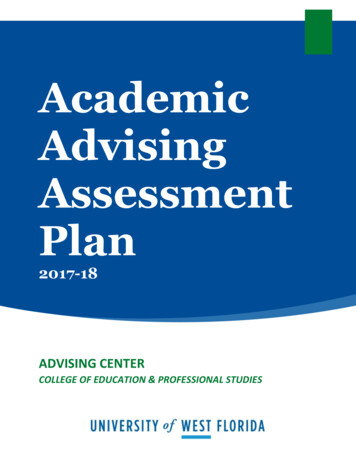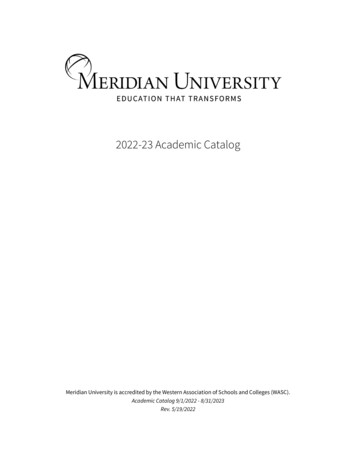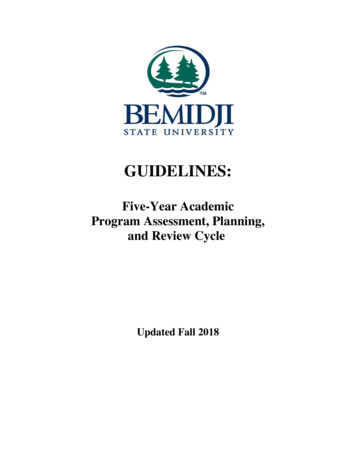
Transcription
GUIDELINES:Five-Year AcademicProgram Assessment, Planning,and Review CycleUpdated Fall 2018
Table of ContentsFive Year Academic Program Planning and Review CycleI. The Five Year Academic Program Planning and Review OverviewA. Purpose of the Assessment Planning and Review ProcessB. Goals of the Program Planning and Review ProcessC. Academic Program Planning and Review Cycle TimelineTimeline SummaryII. Academic Year 1 ActivitiesA. Five Year Department PlanB. Five Year Department Plan FormatC. Suggested Assessment StrategiesD. Funding for Assessment ActivitiesE. Direct, Indirect and Non-Measures of Student LearningIII. Academic Year 2 ActivitiesIV. Academic Year 3 ActivitiesV. Academic Year 4 ActivitiesVI. Academic Year 5 ActivitiesA. Self-Study ReportB. Suggested TimetableC. Developing a Self-StudyD. Selecting and Scheduling an External ConsultantE. Site Visit Interviews/ExpectationsF. Issues to be Addressed by the ConsultantG. Approval of the Consultant Report, Feedback and PaymentAppendix A: Committee ChargesAppendix B: Academic Planning and Assessment FlowchartAppendix C: Dimensions of Student LearningAppendix D: Department/Program Assessment Request for FundingAppendix E: External Consultant’s 12223242529302
Five Year Academic Program Planning and Review CycleTask Tracking FormDepartment/Program:Cycle Year 1:to Cycle Year 5:TaskDate SubmittedDate Approved5-Year Plan, Assessment plan,findings, action plan(Due in fall)Assessment plan update, findingsaction plan(Due in fall)Assessment plan update, findingsaction plan(Due in fall)Assessment plan update, findingsaction plan(Due in fall)Assessment plan update, findingsaction plan(Due in fall)Self-Study Report(Due in November)Consultant Visit in FebruaryConsultant ReportYear 1Year 2Year 3Year 4Year 53
FOREWORDThese guidelines are presented chronologically, beginning with the first year of the five yearacademic program planning cycle. Each stage of the cycle represents an academic year: forexample, Fall 2017 - Spring 2018. Users can use the tracking form on the inside of the previouspage to monitor their progress through each five year cycle.These guidelines are periodically revised to conform to new policies and procedures regardingacademic program planning and assessment. This document was revised substantially in 2010 tomeet the expectations of the Higher Learning Commission for a more focused and systematicassessment process, and to reflect the use of TaskStream for managing the assessment data, andthis 2018 revision has several changes based on reflection on the assessment process from lastprior years.4
NEED ASSISTANCE IN USING THESE GUIDELINES IN YOURDEPARTMENTAL PROGRAM REVIEWS AND ASSESSMENT PLANS?RESOURCES:GENERAL ASSESSMENT HELP:Randy Westhoff (#2016) rwesthoff@bemidjistate.eduAssociate Vice President for Academic Affairs (Interim)QUESTIONS ABOUT TASKSTREAM:Taskstream Help and Mentoring Services 1-800-311-5656 or help@taskstream.comRandy Westhoff (#2016) rwesthoff@bemidjistate.eduAssociate Vice President for Academic Affairs (Interim)ASSESSMENT COMMITTEE MEMBERS (Fall 2018):Randy Westhoff, Associate Vice President for Academic Affairs (Convener)Tony Peffer, Provost and Vice President for Academic and Student AffairsJim Barta, Dean, College of Arts, Education and HumanitiesBonnie Higgins, Dean, College of Business, Mathematics and SciencesJoe Ritter, Dean, College of Individual and Community HealthDouglas Olney, Director of Institutional Research and EffectivenessSeason Ellison, Liberal Education DirectorMahmoud Al-Odeh, Faculty MemberMitch Blessing, Faculty MemberNancy Hall, Faculty MemberKathryn Klement, Faculty Member5
I. The Five-Year Academic Program Planning and ReviewOverviewThe five-year academic program planning and review cycle is a continuous, integrated process ofdecision-making at the departmental/program level linking program improvement and changewith planning and assessment of student learning. The planning process is informed by ongoingassessments of student learning, the development of a self-study report, and a review by anexternal consultant. This process promotes modifications to occur within and between programsand departments based on qualitative and quantitative evaluative factors. Thus, the five yearacademic program planning and review process is a significant building block in the planningprocess adopted by the campus community in 2000.Academic program reviews take the form of a quality audit and consist of the followingelements: 1) a program self-study report (including assessment plans, findings and actions fromthe previous five years), 2) an external reviewer site visit and report, 3) work with an advisoryboard, if applicable and 4) Five-Year Department Plan (new or revised due in the fall of thefollowing year – Year 1 of a new cycle).Programs which are officially accredited by professional program accrediting agencies are thefollowing: Accounting and Business: International Assembly for Collegiate Business Education(IACBE) Chemistry: American Chemical Society (ACS) Music: National Association of Schools of Music (NASM) Nursing: Commission on Collegiate Nursing Education (CCNE) Social Work: Council on Social Work Education (CSWE) Technological Studies: The Association of Technology Management and AppliedEngineering (ATMAE) (some programs)Departments holding current accreditation may coordinate their program reviews andaccreditation activities with their re-accreditation cycle. Data needs to be in a form so that it canbe aggregated for University-wide reporting. If your program is not specifically listed above,and you think it should be, please contact your dean.In collaboration with the Deans, the Provost and Vice President for Academic and StudentAffairs schedules program reviews for all academic programs on a five-year recurring interval.The schedule is updated annually and distributed to all academic departments. Departments andprograms invite external consultants to campus to meet with faculty, students, staff,administrators and others after the completion of the department/program self-study report.Following this site visit and after the consultant’s report has been received,departments/programs develop a plan that details departmental goals. Consultant reports oftenhave budgetary recommendations for personnel and other resources (equipment, laboratory6
space, etc.) that become part of the department/program plans and position/budget requests.These in turn influence university budgeting, planning and decision-making processes.Assessment and Planning CycleAssessmentinformation andSelf-study toconsultantProgram makesimprovementsbased onassessment dataand otherinformationProgramimplements plan;University makespersonnel andother budgetdecisionsConsultant visitsand submitsreportProgramdevelopes Fiveyear Plan,position andother budgetrequestsThe assessment of student learning constitutes one foundation upon which decisions aboutprogrammatic direction are based. Each year, programs review and potentially revise theirassessment plan, list their assessment findings, and describe actions taken and current status oftheir assessment program, in order to ensure that the assessment process occurs on a regularbasis.The Assessment Committee develops and oversees the five-year planning procedures andsummarizes the results of assessment and five-year review materials looking for trends inassessment results. The committee communicates findings to the Vice President for Academicand Student Affairs each spring. The composition and charge of the Assessment Committee is inAppendix A.7
A. Purpose of the Assessment, Planning, and Review ProcessThe primary purpose of assessment is to improve student learning. This is done through asystematic, continuous process of data collection, review, and action. Through this assessmentprocess, we generate information that is of value in internal program-level decision-making, aswell as to external constituents, such as the Higher Learning Commission.The planning and review process for programs and departments is integrated with assessment todemonstrate program effectiveness and integration with college and university planninginitiatives, including the Master Academic Plan and University Strategic Plan.B. Goals of the Program Assessment Planning and Review ProcessProgram review goals are three-fold, incorporating the needs of the department/program, theuniversity, and constituencies outside of the university.1. Internal to the Department/Program to monitor and enhance the quality of the learning experienceto assist the department in decision making and planningto maintain high quality academic programsto promote excellence in teachingto promote excellence in research and scholarshipto promote excellence in service to the University and societyto provide accountability.2. Internal to the University to monitor and enhance the quality of the learning experienceto assist University budgeting, decision making and planningto inform students about program qualityto provide internal accountability3. External to the University to inform prospective students, parents, prospective employees and employersabout program quality to provide appropriate performance measures and standards in all areas ofacademic activity to provide external accountability to regional andprofessional accrediting bodies, Minnesota State, and the state and federalgovernments.8
C. Academic Program Planning and Review Cycle TimelineThe timeline for a typical five-year review and planning cycle, beginning with the yearimmediately following the external consultant visit, is as follows:Academic Year 1: Submit assessment findings and action plans; create new Five-YearDepartment/Program Plan and update assessment plan; begin implementing Five-YearDepartment/Program Plan and collect and analyze assessment data: Submit assessment findings and action plans based data collected the prior year. Due inSeptember. Update Mission and Vision, Learning Outcomes and Curriculum Map. Due in October. Update assessment plan. Due in October. Review Consultant’s Final Report from previous year (year 5) Submit Five-Year Department Plan. Due in November Begin collecting and analyzing assessment data and implementing Five-Year DepartmentPlanAcademic Year 2: Continue implementing Five-year Department/Program Plan and collectingand analyzing assessment data: Implement Five-Year Plan Submit assessment findings and action plans based data collected the prior year. Due inSeptember. Update assessment plan. Due in October. Collect and analyze dataAcademic Year 3: Continue implementing Five-year Department/Program Plan and collectingand analyzing assessment data: Implement Five-Year Plan Submit assessment findings and action plans based data collected the prior year. Due inSeptember. Update assessment plan. Due in October. Collect and analyze dataAcademic Year 4: Continue implementing Five-year Department/Program Plan and collectingand analyzing assessment data: Implement Five-Year Plan Submit assessment findings and action plans based data collected the prior year. Due inSeptember. Update assessment plan. Due in October. Collect and analyze dataAcademic Year 5: Submit assessment findings and action plans based data collected the prior year. Due inSeptember. Update assessment plan. Due in October. Develop Self-Study Report. Due in November9
Select external consultant. Arrange contract once Self-Study has been approved.Make self-study and all assessment plans, findings and action plans for the past five yearsavailable to consultant prior to visit. One way to do this is to publish the Taskstream sitesend the link to the consultant.Conduct external consultant site visit in February.Distribute consultant’s report.Return to Year 1 in the flow chart. Begin work on Five-Year Department/Program Planin response to self-study and consultant’s report.Timeline SummaryAnnually: Collect and analyze assessment data; submit assessment plan, findings and actionplan; continue implementing the Five-Year Department Plan.Every five years: Prepare Self-Study; select external consultant; conduct site visit; prepare newFive-Year Department Plan.Year 1: Fiveyear PlanAnalysis andEvaluationYear 5: Selfstudy andConsultant VisitImplement planCollect &analyze dataYears 1 -5:Yearlyassessmentplan, findingsand action planImplement planCollect &analyze data10
II. Academic Year 1 Activities1. The Department/Program submit assessment finding and action plans from prioryear’s data and updates assessment plan in Taskstream. Due in September andOctober.2. Review Mission and Vision and Learning Outcomes.3. The Department/Program Reviews Self-study and Consultant’s Final Report fromprevious year (year 5).4. The Chair/Program Coordinator Meets with the Dean and/or the Associate VicePresident for Academic Affairs to discuss the self-study and consultant’s report.5. The Department/Program prepares and submits Five-Year Plan to AssessmentCommittee through Taskstream. Due in November.6. Update Mission and Vision, Learning Outcomes and Curriculum Map as appropriatein Taskstream.7. Assessment Committee notifies Department Chairs of 5-year Department andAssessment Plan approval through Taskstream.8. The Department/program begins collecting data and Implementing Five-YearDepartment Plan.A. Five-Year Department Plan (New Cycle)Due Date: NovemberMultiple factors influence academic department planning, including assessment results, changesin the academic discipline, materials compiled in the self-study, external consultant’s comments,available resources, institutional directions identified in the Master Academic Plan, and goals ofeach College.Self-study andAssessment ResultsDiscipline changesConsultant EvaluationFive-YearDepartmentPlanMaster Academic PlanCollege Goalsand Resources11
B. Five-Year Department Plan FormatA template for the Department Plan and Assessment Plan is available in Taskstream.The Five Year Plan document contains the following questions:Introduction: Which program or programs you are reporting on in this document?1.1 College/Program or Departmental GoalsWhich college goals is the program/department addressing? What strategies or activities areplanned to address these goals?1.2.A. Changes based on data from student learning outcomes1.2B Other Program Changes1.3 Advisory boards or other sources of external input1.4 Frequency of Advisory Group Meetings (if applicable)1.5 Role of faculty members in departmental or program assessment2.0 Effective curriculum management.What curricular strategies is the department planning to put in place to maintain reasonablefaculty workloads and timely student progress through the program? Insert a link or attach adocument listing your two or four year course rotation schedule, showing how you plan to teachthe curriculum with existing faculty.3.1 Student SatisfactionDescribe plans to evaluate student satisfaction with the program or department, includingsatisfaction with student advising. Examples of student satisfaction assessments include courseand program evaluations, exit or alumni surveys, and/or program-level data from the NSSE orNoel-Levitz surveys.3.2 Graduation and Retention Rates and Student PlacementReview data on graduation rates, retention rates, and placement at Reports(http://reports.bemidjistate.edu) Based on this data, describe plans to increase graduation rates,retention rates and placement of graduates in professional schools and/or employmentopportunities including specific plans related to Native American and other underrepresentedstudent groups.4.1 New InitiativesDescribe new programming or other initiatives to being undertaken by department/program,which are not described above.12
4.2. Other informationInclude other information not addressed in the previous questions.Mission/Vision and Learning OutcomesMission/Vision statements and the department/program’s learning outcomes should be revised asneeded based on feedback from the consultant visit, disciplinary trends and assessment and otherinformation collected.Assessment PlanThe assessment plan template is part of the Taskstream system. It requires that you havedeveloped a mission/vision statement and student learning outcomes for your program prior todeveloping the plan. For each student learning outcome, your program will be asked enter thefollowing information into Taskstream:Measure(s):Program Level:Details/Description of the measures used:Acceptable target (optional)Ideal target (optional)Implementation plan (timeline)Key Responsible Personnel:Supporting Documents (optional)Curriculum MapAnother key piece of the Assessment plan is a curriculum map. The curriculum map provides agraphical representation of where (and, briefly, how) each outcome is addressed in thecurriculum. This is also part of the Taskstream assessment system. Please note that everyoutcome must be assessed in at least one place in the curriculum. An example would be thefollowing:Course/Activity110021003100MFTOutcome 1IAALegend:I -Introduced P- PracticedReinforced and AssessedOutcome 2IAAR- ReinforcedOutcome 3PSA- AssessedOutcome 4IQAAOutcome 5PSQ- Practiced and Assessed S-We also need departments/programs to explain how their outcomes relate to the University-wideDimensions of Student Learning (See Appendix 3). This involves, in the Student LearningOutcome Section of Taskstream, mapping the outcomes to the Dimensions.13
Assessment Requirementsa. All assessment plans must include “direct” assessment (see below for an explanationof “direct”, “indirect” and “non-measure" methods of assessment).b. Direct assessment should be included for Liberal Education courses and graduatecourses and/or programs.c. Direct assessment should be included for Center for Extended Learning programs.d. Indirect assessments may also be used.C. Suggested Assessment StrategiesListed below are suggested strategies for assessing student learning. Identify the assessmentstrategies for each Student Learning Outcome. Also include a description of how you intend tocollect the data, your timeline, anticipated number of students assessed, and include any formsthe department/program will use to compile the information such as rating scales, rubrics, andother behavioral observation coding forms. Evaluations by Practicum Advisors or Supervisors Exit Interviews Examples of student performance collected as class assignments Pre / Post Tests Focus Groups Portfolios Behavioral Observations Oral Exams Classroom Research Simulation Survey of Students and/or Graduates Capstone Experience Employer Survey Standardized TestsSample Assessment TimelineAcademic ssessment ProjectAssessment of Learning Outcomes 1 and 2Assessment of Learning Outcomes 1, 3, 4Assessment of Learning Outcomes 2, 5Assessment of Learning Outcomes 1,2Assessment of Learning Outcomes 1, 3, 414
D. Funding for Assessment ActivitiesDepartments and programs with approved assessment plans are encouraged to apply for funds tobe used in the implementation of their assessment plans. Up to 1000 for eachdepartment/program is available from the Office of the Vice President for Academic and StudentAffairs to defray the costs of direct measures of assessing student learning and developmentduring each 5-year review cycle. Departments that offer off-campus degree programs in additionto on-campus programs may apply for additional funds up to 1000 for the direct assessment ofstudent learning outcomes in these additional programs. Direct measures of student learning havebeen defined by The Higher Learning Commission’s Associate Director, Cecilia Lopez (see nextsection).Departments and programs requesting funds for assessment should prepare a detailed budget ofassessment expenses including the name and cost of the assessment instrument to be used(if standardized) and an estimate of the number of students to be assessed (see Appendix D). Astatement of how these costs will be used to meet the goals of their approved assessment plan interms of the program’s student learning outcomes must also be attached if the request is notsubmitted with the Five-Year Department/Program Plan.A request for funding using the Department/Program Assessment Budget Form in Appendix Dshould be submitted to the Assessment Coordinator who will bring the request forward to theAssessment Committee which will review the request and provide a recommendation for fundingto the Vice President for Academic Affairs.E. Direct, Indirect, & Non- Measures of Student LearningThe following information is condensed from a report by Cecilia L. Lopez, Associate Director ofour accreditation institution, The Higher Learning Commission:Direct measures of student learning are understood to include but are not limited to: the capstone experience portfolio assessment standardized tests (e.g., Major Field Achievement Test [MFAT] in cognate areas, or, forGeneral Education: the Test of Critical Thinking Ability; the Academic Profile; or theWatson-Glaser Critical Thinking Appraisal) performance on national licensure, certification or profession exams (e.g., ProfessionalAssessment Examination for Beginning Teachers [MTLE]) locally developed tests essay questions blind scored by faculty across the department, division, school, or college qualitative internal and external juried review of comprehensive senior projects externally reviewed exhibitions and performances in the arts external evaluation of performance during internships based on stated program objectivesIndirect measures of student learning, if used alone, are inadequate measures of studentlearning. However, some of these sources, when used to supplement direct measures, provide
information that may enrich or illuminate aspects of what the direct measures tellus about students’ academic achievement. alumni, employer, and student surveys exit interviews with graduating seniors and focus groups graduate follow-up studies retention and transfer studies length of time to degree SAT scores graduation rates and transfer rates job placement dataNon-Measures of student learning can provide valuable information to a department or programas a part of its self-study, but they are not considered as “measures of student learning.” questionnaires asking students if their personal goals for the course or major or programhave been met program evaluation reports which collect data on the quality of curriculum and otheraspects of a program, including:-instruments designed for specialized program review such as the MichiganProgram Review of Occupational Education (PROE)-curriculum review reports-evaluation reports of individual programs submitted by program-specific andspecialized accrediting agencies, visiting committees, or committees of externalpeer expertsNon-Measures of student learning also include information gathered not for assessment but forspecific administrative purposes, such as: faculty publications and recognition the kinds of courses or majors students select, including course enrollments and courseprofiles faculty/student ratios the percentage of students who study abroad; enrollment trends the percentage of students who graduate with the baccalaureate in five years the diversity of the student body grades and GPAs16
III. Academic Year 2: ActivitiesContinue implementing Five-year Department Plan and collecting and beginning to analyzeassessment data: Continue Implementing Five-Year Department Plan Reporting on findings from prior year using Taskstream Reporting on the assessment action plan using Taskstream Updating assessment plan (as needed) Data Collection and AnalysisIV. Academic Year 3Continue implementing Five-year Department Plan and collecting and beginning to analyzeassessment data: Continue Implementing Five-Year Department Plan Reporting on findings from prior year using Taskstream Reporting on the assessment action plan using Taskstream Updating assessment plan (as needed) Data Collection and AnalysisIV Academic Year 4Continue implementing Five-year Department Plan and collecting and beginning to analyzeassessment data: Continue Implementing Five-Year Department Plan Reporting on findings from prior year using Taskstream Reporting on the assessment action plan using Taskstream Updating assessment plan (as needed) Data Collection and AnalysisVI. Academic Year 5: Self Study, Consultant Visit andReport Continue Implementing Five-Year Department PlanReporting on findings from prior year using TaskstreamReporting on the assessment action plan using TaskstreamUpdating assessment plan (as needed)Data Collection and AnalysisDevelop Self-Study Report. Due in NovemberSelect external consultant. Arrange contract once Self-Study has been approved.17
Make self-study and all assessment plans, findings and action plans for the past five yearsavailable to consultant prior to visit. One way to do this is to publish the Taskstream sitesend the link to the consultant.Conduct external consultant site visit in February.Distribute consultant’s report to Department, Dean, Associate Vice President forAcademic Affairs.Dean reviews and approves consultant report in consultation with Chair.Dean notifies department of Self-study Report approval.Begin work on Five-Year Department Plan (New Cycle) in response to self-study andconsultant’s visit.Return to Year 1 step in the flow chart. Begin Developing New Five-YearDepartment/Program PlanA. Self-Study ReportSelf-Study Report Due Date: November 1Departmental/Program Self-Study document information (will be entered in TaskStream):Programs Being ReportedPlease include a list of programs that are included in this self-study document.Introduction1.1 Departmental HistoryProvide a brief history of the department, including a summary of major changes to programofferings.1.2 Department/program mission and visionPlease enter your department's mission and vision statement below.1.2B Other Program ChangesDescribe recent and planned changes, aside from those based on assessment of student learningoutcomes (which are addressed below). Include changes based on the self-study process andother factors. (Attach reviewer comments from the last self-study report and any departmentalresponse as a link.)1.3 Relationship of Student Learning Outcomes to University and Departmental Missions1.4A Advisory BoardsDuring this past five-year period, did the department have an advisory board?1.4B Input from Advisory Boards or other external groupsIf the department/program had an advisory board please describe the advisory board including itscharge, provide a membership list, and indicate what decisions were affected by input from theadvisory board.18
1.5 Labor Market InformationThe System Office requires programs to include information about the labor market, ifpreparation for an occupation or profession is a stated purpose of the program.1.6 Labor market informationIf you answered "Yes" to the previous question, please include labor market information.Sources of this information would include the Bureau of Labor Statistics(http://www.bls.gov/oco/) and the Minnesota Department of Employment and EconomicDevelopment (http://www.positivelyminnesota.com), employer surveys, or other appropriateinformation. Attach any relevant electronic documents to your self-study.2.1 Summary of Assessment FindingsBased on the past five years of departmental or program assessment data of student learningoutcomes, provide a summary of the key findings. Note: This is a key part of this report, criticalfor both internal review, and for evaluation by our accrediting body.2.2 Changes Based on Assessment DataProvide a clear summary of changes that have occurred in response to the assessment data andother information during the past five year self-study period. Include a description of theassessment data or other information that led to those changes. Note: This is a key element thereport, critical for both internal review, and review by our accrediting body.3.1 Effective Curriculum ManagementDescribe how the program/department managed its curriculum in a way that minimized the useof adjunct and overload, and allowed students to progress in a timely manner. Based on theenrollment data from the past five years found at Reports (http://reports.bemidjistate.edu)describe how the department used course rotation and other strategies to eliminate the need tooffer very low-enrollment courses (i.e. courses with fewer than 10 students). Please attach theenrollment document to your self-study report.4.1 Student SatisfactionWhat evidence has the department collected that shows student satisfaction with theprogram/department, including satisfaction with departmental advising?4.2 Graduation Rates and Student PlacementWhat does the data from Reports (http://reports.bemidjistate.edu) from the past five yearsindicate about changes the program has made in attempts to affect retention rates, graduationrates, and student placement in professional schools or employment opportunities? Yourresponse should include specific information about Native American and other underrepresentedstudents. Please attach the retention and graduation report to your self-study document5.1 New Program OpportunitiesDescribe any possible new program opportunities based on assessment data and/or departmentalevaluation of changes in industry, society and their disciplines5.2 Other information not included above19
B. Suggested Final Year Timetable October/November: Department/program self-study report completed in Taskstream;Arrange for external consultant visit; contract once consultant and self-study report havebeen approvedJanuary: Make self-study and all assessment plans, findings and action plans for thepast five ye
assessment plan, list their assessment findings, and describe actions taken and current status of their assessment program, in order to ensure that the assessment process occurs on a regular basis. The Assessment Committee develops and oversees the five-year planning procedures and
